
By Brian Mutzabaugh
Photos by Bob Bartosz
Conducting live fire training in an acquired structure is without question one of the most resource-intensive training exercises a department can undertake. Typically, the host agency spends countless hours over several days or weeks in preparing for what will ultimately last just a few hours on a Saturday afternoon. Numerous personnel and apparatus from multiple departments and a large instructor cadre will have to be assembled to make sure all positions are filled. The realism of the training means an increased risk of injury, which some departments see as reason enough to steer clear of this type of training altogether. In some jurisdictions, conducting live fire training with acquired structures is banned, forcing departments to use designed burn buildings or entirely miss out on this valuable training. With all that said, given the opportunity, how can we optimize our firefighters’ training when it comes to evolutions in an acquired structure?
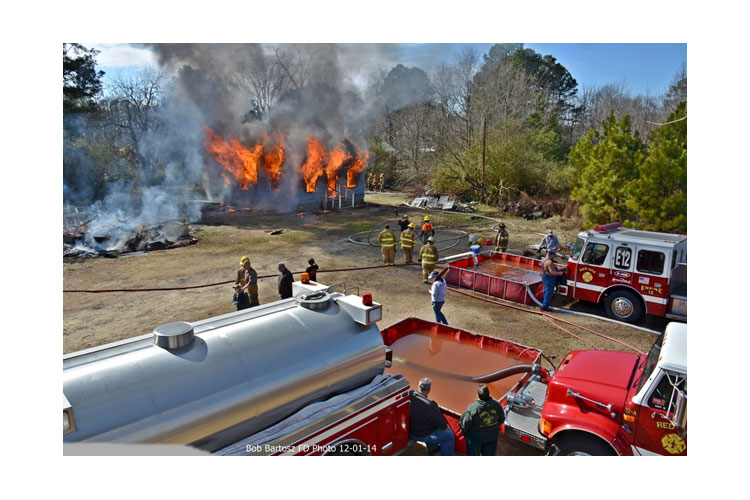
(1) After completing interior operations, personnel reposition and conduct the burn down of a single-story wood framed acquired structure.
Shortly after joining the fire service in 1996, I developed a deep passion for conducting live fire training, specifically in acquired structures. I was fortunate to have the opportunity to volunteer and then work with several very talented and enthusiastic instructors who were willing to take me under their wing. Since that time I’ve had the opportunity to serve in various roles during live fire training evolutions in both acquired structures and designed burn buildings. Although designed burn buildings have their place in the training environment, I am a firm believer that the most realistic fire training is conducted in acquired structures. These types of training evolutions allow for conditions found on the fireground to be more closely replicated. Crews are allowed to actually open up ceilings and walls, vent windows and roofs, and maneuver through a dwelling that was designed and built to be lived in. For those reasons, among others, let’s focus on ways we can get the most out of live fire training in acquired structures. Given all the time spent preparing these structures for the training evolution, don’t rush through it and waste an opportunity to hone multiple skills.
RELATED: Conducting NFPA 1403-Compliant Live Burn Training in Acquired Structures | Live Fire Training: Lessons Learned in New Jersey |Burning Issues: LIVE FIRE TRAINING vs. LITTLE CIRCUSES
Acquiring and Preparing the Structure
It’s only fair to spend a few minutes discussing the acquisition and preparation phase of the process. Typically, a citizen or town administrator may reach out and ascertain if the department can burn a structure for training. If you are unfamiliar with the process, a call to your local community college or fire marshal’s office may prove beneficial. A representative from one of these agencies may be able to provide invaluable guidance and assist with completing the necessary paperwork to be completed. I like to arrange a meeting with the property owner at the proposed training site and conduct a walk-through of the building before any commitments are made. This gives me an idea if the structure is in good enough condition to conduct interior evolutions in or whether it is even safe to burn based on location of exposures, etc. I also like to ask the owner if they have a time frame of when they would like the structure to be burned down by. Because of the requirements in my area, I typically won’t agree to burn a structure if I don’t have a minimum of 90 days to prepare. In addition to the paperwork, inspections and notifications that must be made, and I also have to ensure that sufficient personnel and apparatus are available to safely conduct the training. When working with volunteer companies, getting sufficient resources on a particular day for training can prove difficult when battling career commitments and other family obligations. The following is a list of some of the required documentation you will need at a minimum prior to the training evolution taking place.
- Permission from the property owner to burn the structure
- Release of liability for all agencies involved in the training evolution
- Proof of cancelled insurance on the property
- Proof of clear title
- Asbestos inspection report
- Demolition permit
- Acknowledgement of post-burn property conditions
- Release of property form, which explains the expected condition of the property after the training evolution and explains that the department IS NOT responsible for site cleanup of remaining debris.
- Applicable burn permits
- Notification to applicable governmental agencies (air quality, office of the state fire marshal, city/town official(s), etc.)
- Termination of all utility services (gas, electric, water, etc.)
- Notification of training to area residents, which includes the date, beginning and ending time of the training evolution, expected smoke conditions, road closing and detours, post-burn hazards on the property, etc.
- Documentation of required prerequisite training for attending personnel
- Site map(s) showing apparatus staging, EMS staging, privately owned vehicle parking, emergency evacuation area, hose lay out, floor plan, nozzle flows, water points, etc.
- Required fire flow, including reserve, and necessary apparatus to supply it for the duration of the event. Don’t forget that National Fire Protection Association (NFPA) 1403, Standard on Live Fire Training Evolutions, requires the attack and back-up pumper have separate water sources and an additional 50 percent reserve flow be calculated into the required fire flow of the structure based on construction type and size and taking into consideration any exposures.
Although the above list is not all inclusive, you can easily see the substantial amount of preparation that goes into setting up a live fire training evolution of an acquired structure. This is why it’s important to make sure you have adequate time to prepare. You do not want to rush through the process and find out the day of the training evolution that required paperwork has not been completed and the burn cannot take place. Trying to convince surrounding departments to come back another day because you failed to prepare may be almost impossible. Take your time and use available resources to assist you in preparing for the live burn. Taking the time up front will make the day of the live burn more enjoyable for everyone involved and minimize the stress placed on you to ensure the training is conducted safely.
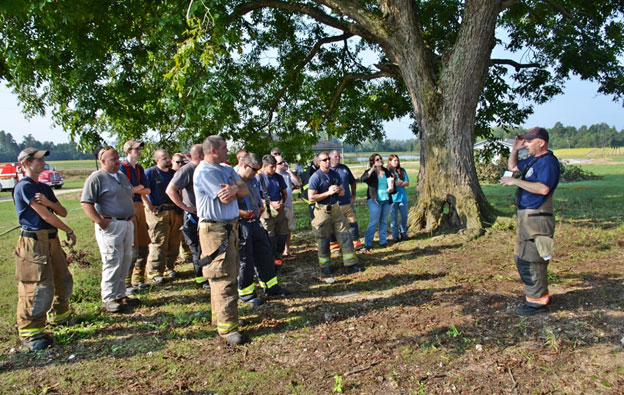
(2) Personnel meet to review the live fire incident action plan (IAP). This includes crew assignments, a walk-through of the structure noting entry/egress points, location of fire sets and demonstration of the evacuation signal (typically repeated blast of air horns with all personnel meeting at a predesignated assembly area and a PAR check completed).
Establishing Training Objectives
As you approach the training date, schedule a meeting of all involved agencies to conduct a pre-burn briefing. This is a good time to cover a lot of information to minimize confusion on the day of the live burn. With all the paperwork you will collect in the preparation phase, it is a good idea to assemble a book to organize the documents. You can use this book in your pre-burn meeting to discuss where apparatus will park, which water points you will use, where personnel should meet, where hand tools and loose equipment should be staged, etc. You can also distribute the necessary paperwork to each department that documents required prerequisite training so it can be filled out and signed by the fire chief and returned on the day of the live burn. With everyone in attendance, you can develop training objectives based on the experience of the personnel involved. This is when you can maximize the training evolution and make sure you get the most bang for your buck.
RELATED: Planning a Training Fire Compliant with NFPA 1403 in an Acquired Structure | Live Burn: 1403 or No Fire! |Training in Acquired Buildings: The Department’s Roles
When you begin to develop the objectives, think of the live burn as if you were responding to a fire in the acquired structure. Consider all the strategic and tactical objectives and find a way to include them in the training evolution. New or less-experienced chief officers can be paired with a seasoned chief to assume the role of incident commander (IC). Line officers can work on maintaining crew integrity, carrying out crew assignments, and reporting their status to the IC, etc. Firefighters of all experience levels can hone their skills to include hose advancement, nozzle control and stream application, opening up to find and extinguish hidden fires in ceilings and walls, vertical and horizontal ventilation, managing the flow path by controlling doors, coordinated positive pressure ventilation using blowers, and on and on and on. Make sure that personnel aspiring to be driver/operators are involved and given the opportunity to establish the water supply, work on drafting, charge attack lines, maintain proper discharge pressures, and monitor their apparatus throughout the event. Allow them to communicate with the IC regarding residual pressure for additional lines if needed. Ask them how they would or could get more water if needed on the scene of an incident. If the training evolution goes into the evening, have them set up scene lighting to improve visibility.

(3) A primary attack pumper and back-up pumper are supplied from separate dump tanks. This provides a secondary water source in the event the primary pumper has a mechanical issue and goes out of service during the live burn.
Take the time to look at what the structure has to offer and make the most of it. If you have exterior doors that are intact, consider disabling the door knob and any other locks. Using small strips of wood (paint sticks cut to fit across the interior of the door frame and jamb), you can repeatedly simulate forcing entry with hand tools on each fire attack. Once the fire room is extinguished and you’re ready to move to another room, you can attach new wood strips, simulating the door is locked and requiring the
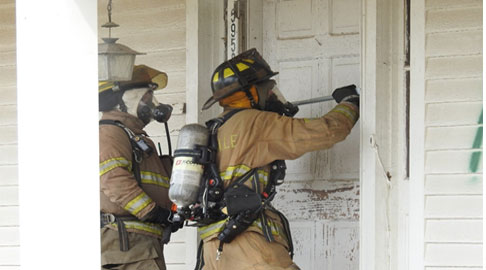
(4) Personnel force entry into the front door of an acquired structure during a live burn training evolution. This maximizes the training by creating realistic objectives that must be accomplished.
initial attack team to force entry. Although it is not permissible to use live simulated victims in a live burn, you can use a life-size mannequin, hose dummy, etc. This will allow you to designate a search team and provide a simulated fire victim to locate and remove under fire conditions. Make sure that crews know to communicate all progress to the IC by radio as they would on an actual fireground. This reinforces good communication skills and provides data that can be used in the post-burn debriefing.
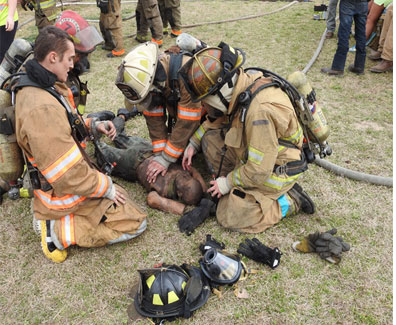
(5) A search crew has removed the simulated victim and immediately begins CPR in the front yard while simultaneously notifying EMS.
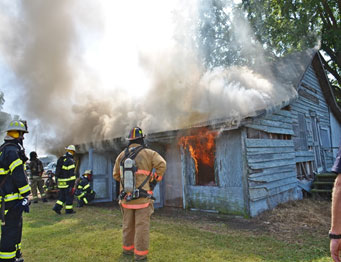
(6) Live burn instructors monitor interior conditions as a crew makes their way into the structure to extinguish a fire in an acquired structure.
As you finish interior operations it will be time to transition to the burn down portion of the training exercise. Depending on conditions, it’s best to extinguish the fire to the point that you can take your time and position personnel and equipment accordingly. I have attended live burns at which, after the last evolution is completed, the IC gives the evacuation signal and allows the structure to go into free burn. At times, you have people scrambling to position exterior hoselines, account for and move equipment, etc. Making a slower transition to burn down allows the process to be conducted more safely and efficiently. Additionally, the burn down is a great opportunity to get newer firefighters who have not been cleared for interior operations some much needed nozzle time. Throughout the day, these members should have been assisting with filling SCBA cylinders, moving equipment, setting up ladders, assisting with water supply, providing rehab supplies to interior firefighters, etc. Now is the time where they can receive a bit of a reward and allowed to handle hoselines and direct fire streams from a safe location on the exterior of the structure. They can also serve as exposure protection crews during the training evolution as long as an experienced firefighter or officer remains with them to monitor the conditions they are not familiar with experiencing yet.
Laying out the objectives ahead of time will allow you and the instructor cadre to ensure the needed resources are allocated for the training evolution. This again allows the live burn to flow more efficiently since you know prior to starting the first fire what you expect to accomplish.
Don’t Be Discouraged – Go the Extra Mile
Although the overall cost of conducting a live burn is typically minimal for the host agency, don’t let minor problems with the structure discourage you. If funds are available in your training budget, making minor repairs to an acquired structure can prove extremely beneficial considering the quality of training you can offer. If multiple departments are involved, speak with those agencies and see if the cost of repairs can be divided up. Also be willing to contact a local building supply store and see if they would like to make a donation in the form of supplies to help all departments hone their skills and better serve their communities. I have been fortunate enough to acquire several sheets of sheetrock and plywood that were damaged on delivery and could not be sold at regular price. Typically the repairs you need to make may only require partial sheets or enough material to make small patches. If you are running the live burn through a community college, that institution may be willing to supply some material in exchange for the credits they will receive from students enrolled in the training evolution.
*
As with any training, the success of a live burn evolution is largely determined by the instructors delivering the class and the environment created to train in. It is understood that an instructor has strict requirements on how a certification class is delivered and ultimately tested. However, in most cases a live burn of an acquired structure does not carry a certification and subsequent test. The instructor in a live burn training exercise should work closely with the host agency to try and incorporate as many of the objectives as possible without jeopardizing the safety of the participants. To make the training beneficial, the host agency should take every opportunity to provide realistic training to its members as often as possible. Using acquired structures for training does have its challenges and a lot of preparation must go into it. As stated before, those bumps in the road should not easily dissuade you from carrying out the training and providing your members with an opportunity to hone their skills. We owe it to our personnel at all levels a chance to put the individual skills they acquire along the way to good use. I firmly believe that conducting live training evolutions in acquired structures provide the optimum backdrop.
Brian Mutzabaugh has more than 24 years of experience in the fire service. He is employed by the City of Rocky Mount (NC) Fire Department as an engineer assigned to Rescue 2. Since 2011, Brian has also served as the fire chief of Whitakers (NC) Volunteer Fire Dept., Inc. Brian is a qualified fire instructor through the North Carolina Fire Rescue Commission and regularly teaches fire-rescue classes through Nash Community College.
RELATED TRAINING
Live-Fire Training LODDs: We Must Heed the Lessons Learned
PHYSIOLOGICAL RESPONSES OF TRAINING OFFICERS DURING LIVE FIRE TRAINING

